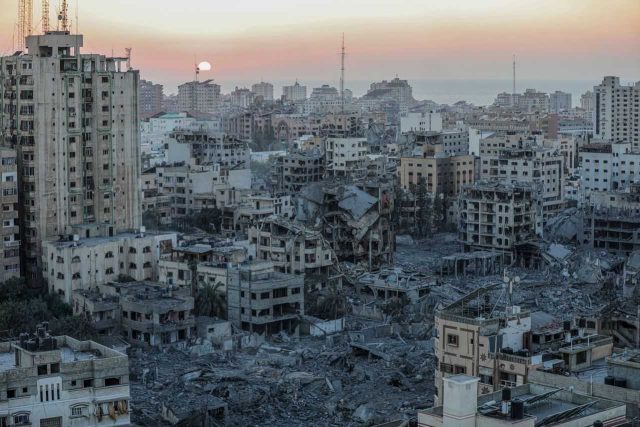THE PAST
The health system in Gaza prior to this current crisis faced numerous challenges rooted in a
complex geopolitical situation. The true history that depicts the perfect view of the situation cannot be ignored.
The health system in Gaza prior to this current crisis faced numerous challenges rooted in a
complex geopolitical situation. The Israeli blockade of Gaza since 2007, when Hamas rose to power, combined with the intermittent conflicts that have occurred, has left the health
infrastructure and services fractured, of varying quality, and with a limited number of specialized health services and technology.
The blockade has complicated the importation of essential medical supplies and equipment, and there are frequent shortages. Health care workers in Gaza have been incredibly resilient and dedicated despite these challenges. However, there remain human resource gaps, particularly in specialty areas like oncology, where Palestinians need to go outside of Gaza to receive some treatments.
The socioeconomic, political, and environmental factors in Gaza combined with these challenges to the health system culminate in a fragile health status of many Palestinians in Gaza. While there have been some improvements over the past decade, life expectancy is lower and infant and maternal mortality rates are higher compared to other areas in the region.
There is a high prevalence of non-communicable diseases, particularly diabetes, hypertension, and cardiovascular diseases. Mental health issues among children and adults are particularly high, driven by numerous factors including recurrent hostilities. Rates of acute and chronic malnutrition are unacceptably high, particularly among children. Lack of access to clean water and sanitation is persistently a challenge.
THE PRESENT
What are some of the greatest health concerns for civilians in Gaza related to the current crisis? From a public health and humanitarian perspective, there are already massive red flags and major alerts as we discuss this situation right now, well before any potential ground invasion by Israel.
The complete blockade of Gaza does not allow for the importation of basic lifesaving services like water, electricity, food, and medical supplies into a densely populated and circumscribed area. Combined with bombing, a massive number of civilians being displaced, and attacks on health care facilities, this is a toxic brew for epidemics, exacerbations of existing illnesses, and increased morbidity and mortality.
The increases in trauma and injury due to bombings have already overwhelmed a challenged health system that is under attack. Epidemics, particularly of waterborne diseases like cholera, are of great concern. With respect to maternal and neonatal health services, which have the goal of ensuring safe deliveries, the World Health Organization (WHO) estimates there are 50,000 pregnant women in Gaza struggling to receive basic health services. Contributing factors include overwhelmed hospitals, movement restrictions, and lack of hospital space.
Many civilians, particularly the elderly, who suffer from chronic non-communicable diseases will not be able to continue with their care. Deaths will increase due to a lack of insulin and lifesaving cardiac medicines, the inability to continue with renal dialysis, and so many other issues related to lack of continuity of treatment. On top of all of this are concerns about COVID, influenza, RSV, and other infectious diseases.
THE FUTURE
“It’s not just bullets and bombs. I have never seen health organizations as worried as they are about disease in Gaza” opined by Prof. Devi Sridhar a professor of global public health at the University of Edinburgh, in her interview with The Guardian.
The Israel-Gaza war has set several world records. It’s the deadliest conflict for journalists in 30 years. It has caused the largest single loss of life for United Nations staff in the history of the organization. It is set to have the worst ever total number of attacks on healthcare facilities and their personnel, and has devastated schools, with 51% of education facilities damaged. International rules such as the Geneva conventions have not been respected: hospitals and ambulances have been targeted, medical relief organizations such as Doctors Without Borders (MSF) and Save the Children are under attack, and have lost staff members.
The Israel-Gaza war is also deadly for children, reportedly the deadliest conflict for children in recent times: roughly 160 children were being killed a day last month according to the World Health Organization. Compare this with three a day in the recent conflict in Syria, two a day in Afghanistan, and 0.7 a day in Ukraine. The total number of children killed is already more than 5,300 says UNICEF, the United Nations Children’s Fund.
They didn’t choose to be born there, and are innocent, but are bearing the brunt of these attacks.
Tragically, the nearly unprecedented death and injury we have seen so far is likely to only be the beginning. From looking at similar conflicts across the world, public health experts know that we are likely to see more children dying from preventable disease than from bullets and bombs. While the Israeli government has spoken about safe zones for families to flee to, these aren’t anywhere near what we would consider safe public health zones.
They don’t have clean water, functional sanitation and toilets, enough food, or trained medical staff with medicine and equipment. These are the basic needs, that any human, especially babies and children, need to stay healthy and alive.
The WHO spokesperson Dr. Margaret Harris has said that diarrhea rates among children in
refugee-like camps (sheltered housing) in Gaza were, in early November, already more than 100 times normal levels, and with no treatments available, children can become dehydrated and die quickly. Diarrheal diseases are the second leading cause of death in children under five worldwide, and they are caused by contaminated water sources and lack of access to oral rehydration fluids.
Upper respiratory infections, chickenpox, and painful skin conditions have also increased, and they are fears that the recent floods may result in untreated sewage mixing with fresh water used for drinking and cooking and cause a cholera outbreak. Disease has played a role in battle for centuries. During the American civil war, two-thirds of the estimated deaths of soldiers were caused by pneumonia, typhoid, dysentery and malaria. In 1994, two diseases, cholera and dysentery, linked to unclean water and conflict zones, killed more than 12,000 Rwandan refugees in only three weeks in June 1994.
An estimated 85% of Gaza’s inhabitant are already displaced according to the UN Relief and
Works Agency. Experts analyzing previous refugee displacements estimate in the Lancet that crude mortality rates (that is deaths per 1,000 people) were more than 60 times higher than when each conflict began, on average. Extrapolating this to the current situation in Gaza, where the crude death rate before the conflict was 3.82 in 2021 (relatively low because of its young demographic), mortality rates could reach 229.2 in 2024 if the conflict and displacement continue at the current level of intensity, and Gazans continue to lack access to sanitation, medical facilities and permanent housing.
Ultimately, unless something changes, the world faces the prospect of almost a quarter of Gaza’s 2 million population – close to half- a million human beings – dying within a year. These would be largely deaths from preventable health causes and the collapse of the medical system. It’s a crude estimate, but one that is data-driven, using the terrifyingly real numbers of deaths in previous and comparable conflicts.
International organizations are trying to raise the alarm about this situation, with UNDP lamenting:
“It seems the world has lost its moral compass.” UNICEF has warned: “Lack of water, food,
medicine and protection is a bigger threat than bombs to the lives of thousands in Gaza.”
I have been working in global healthcare research for 5 years now, and I have never heard health and aid organizations as forthright and concerned as they are about the level of suffering and deaths in Gaza. It is an unprecedented conflict, breaking the most tragic records, and while experts might debate whether it’s a genocide or not, the truth is we’re witnessing the mass killing of a population, whether by bomb, bullet, starvation or disease.
Gaza’s ‘catastrophic’ health situation almost impossible to improve, says WHO.
The situation is SCARY and the FUTURE is FLUID!
(The writer is a clinical investigator, prolific columnist, a medical researcher, journalist, data & policy analyst with five years of experience in his professional career)
















